, Yasuya Nomura2 and Yasuya Nomura3
(1)
The Society for Promotion of International Oto-Rhino-Laryngology, Tokyo, Japan
(2)
The University of Tokyo, Tokyo, Japan
(3)
Showa University, Tokyo, Japan
Abstract
Since its first description in a paper by Prosper Ménière in 1861, the inner ear disorder consisting of malfunction of the vestibular and auditory systems has occupied a primary position in clinical and research fields in otology. Seventy-five years have passed since the discovery of endolymphatic hydrops in patients with Meniere’s disease, and many features of the disorder have been elucidated, yet many remain unresolved.
This chapter introduces the following recent research: a histopathological study of the temporal bone, visualization of endolymphatic hydrops using gadolinium MRI, experimentally induced endolymphatic hydrops, optical coherence tomography for visualization of hydrops, vestibular evoked myogenic potentials in Meniere’s disease, and the use of gentamicin as a treatment.
It is possible to visualize endolymphatic hydrops with the use of gadolinium in magnetic resonance images. Intratympanic or intravenous administration of gadolinium moves to the perilymph. In patients with endolymphatic hydrops, enlarged endolymphatic spaces occupy the perilymphatic space. Thus, reduced contrast media enhancement indicates an enlarged endolymphatic space, or hydrops. The clinical use of vestibular evoked myogenic potential testing will shed new light on the function of the otolithic organs in vestibular diseases, including Meniere’s disease.
Keywords
Endolymphatic hydropsExperimentGadolinium MRIGentamicinMeniere’s diseaseOptical coherence tomographyTemporal bone histopathologyVestibular evoked myogenic potentialVisualization of hydrops5.1 Discovery of Endolymphatic Hydrops in Meniere’s Disease
1938 was a memorable year in the history of Meniere’s disease because it saw the publication of two papers concerning the histopathology of the temporal bone in patients with the disease. These papers were written by Yamakawa [1, 2] and by Hallpike and Cairns [3].
Yamakawa was professor and chairman at the Osaka Imperial University in Japan. He had studied the histopathology of the human temporal bone for 2 years under Professor Wittmaack in Germany. Yamakawa presented his paper entitled “Über die pathologische Veränderungen bei einem Meniere-Kranken” at the 42nd General Assembly of the Oto-Rhino-Laryngological Society of Japan on April 3 and 4, 1938 in Kyoto. This society was a section of the 10th Japanese Medical Congress. The patient described in the paper was Yamakawa’s colleague, who was professor and chairman of Obstetrics and Gynecology at the same university. In his will, the patient requested that Yamakawa study his temporal bones.
The main change in this patient’s temporal bone was distension of Reissner’s membrane. The membrane was 1,240 μm long (normally 740 μm) in a portion of the basal turn, and it was 1,160 μm long (normally 740 μm) in the upper turn. Thus, it was almost twice its normal width. Yamakawa described the shape of the distended Reissner’s membrane as “bulging out to the perilymphatic space in the upper turn, while partly bulging and partly wavy in the lower turn.” The organ of Corti and tunnel fibers appeared to be normal (Fig. 5.1). The spiral ganglion and Scalpa’s ganglion were normal. The maculae sacculi and utriculi showed mild postmortem changes. Blood vessels were filled in the stria vascularis, and in several locations there were laminated uneven spherical calculi. Stimulation from the calculi results in increased endolymph secretion. This increase leads to functional disturbances of the inner ear sensory cells. Yamakawa thought that these changes would cause an attack of Meniere’s symptoms. Restoration of the disturbed functions occurs after pressure decreases through diffusion and resorption of the endolymph and widening of Reissner’s membrane.
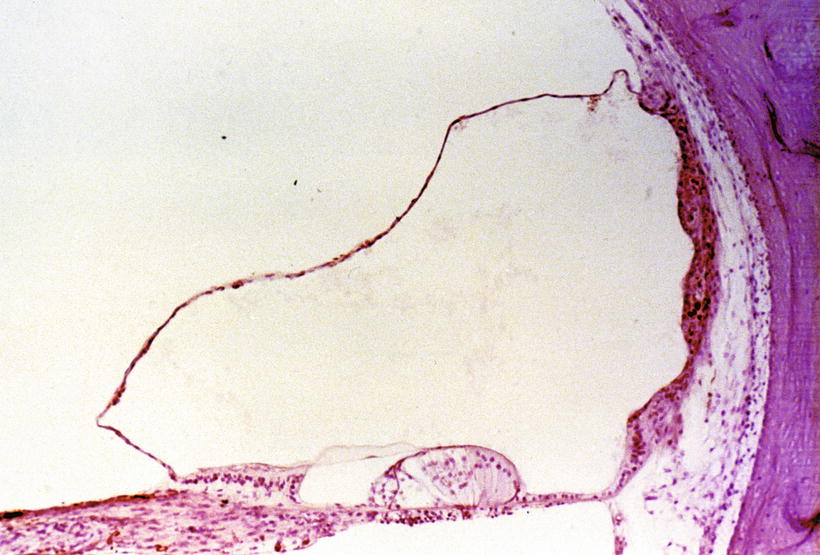

Fig. 5.1
Histopathology of a case of Meniere’s disease reported by Professor Yamakawa. Reissner’s membrane shows marked distension. The organ of Corti is normal (Courtesy of Professor Kubo)
Stahle [4] and Paparella et al. [5] described Yamakawa and his temporal bone studies in more detail.
Hallpike and Cairns published their paper in the Journal of Laryngology and Otology under the title “Observations on the pathology of Meniere’s syndrome” [3]. They described hydrops in their patients as “gross dilatation of the saccule and scala media with obliteration of the perilymph spaces of the vestibule,” (case 1) and “gross dilatation of the saccule and scala media with obliteration of the perilymph cistern of the vestibule and the scala vestibuli” (case 2). Their detailed descriptions of histopathological findings in Meniere’s disease have greatly influenced research and clinical studies of the disease.
The term endolymphatic hydrops was not used in either paper published in 1938. How did researchers express “endolymphatic hydrops” at that time? Hallpike and Wright [6] used the term endolymphatic distension in their paper in 1939, Rollin [7] described das Labyrinthhydrops, Altmann and Fowler [8] discussed dilatation of the cochlear duct and dilatation of the endolymphatic system, Lindsay described labyrinthine dropsy in 1946 [9], and used the term labyrinthine hydrops in 1959 [10]. The term “endolymphatic hydrops” has gradually prevailed since the work of Henry Williams [11].
5.2 Human Temporal Bone Study
The term “endolymphatic hydrops” has been conceptually used as an alternative name for Meniere’s disease, although the condition is not pathognomonic for Meniere’s disease. To understand the signs and symptoms of patients with Meniere’s disease, we must investigate the sites and severity of inner ear hydrops in these patients.
Okuno and Sando [12] reported their histopathological study of 22 temporal bones from 16 individuals with Meniere’s disease. The temporal bone specimens were from the collection of the Massachusetts Eye and Ear Infirmary. According to Okuno and Sando, endolymphatic hydrops was more often observed in the pars inferior (22/22) than in the pars superior (16/22) of the temporal bone (Fig. 5.2). Severe hydrops was observed most frequently in the saccule, followed by the cochlea, the utricle, and the three semicircular canals.
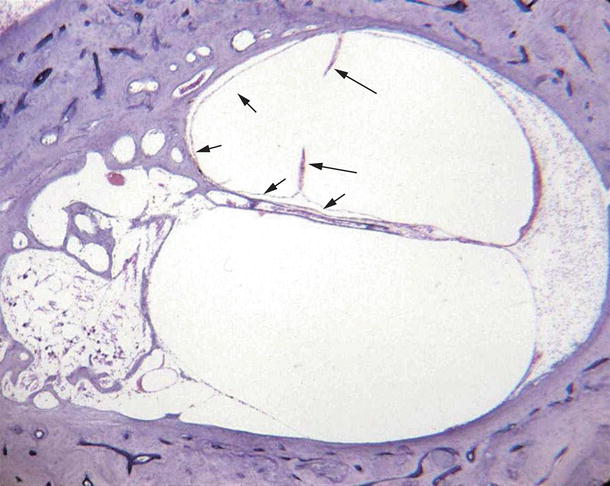

Fig. 5.2
Marked distension of Reissner’s membrane. The scala vestibuli is completely occupied by the endolymphatic space. Small arrows: distended Reissner’s membrane. Large arrows: infoldings (Courtesy of Dr. Okuno)
Saccular hydrops was observed in 19 of the 22 temporal bones. In 17 of these cases the saccular space had expanded laterally toward the footplate of the stapes, touched the footplate, and occupied the vestibular perilymphatic space inferolateral to the utricle.
Utricular endolymphatic hydrops was observed in 11 of 22 bones. In nine of these cases, the utricular membrane had expanded into the superomedial part of the vestibular perilymphatic space and then herniated into the common crus. The utricle had not expanded anterolaterally to the footplate of the stapes. The authors noted that hydrops was severe in individuals with a long history of Meniere’s disease, whereas when the disease had been of shorter duration the hydrops was less severe.
Histopathologically, endolymphatic hydrops in Meniere’s disease is classified into three groups (Fig. 5.3):
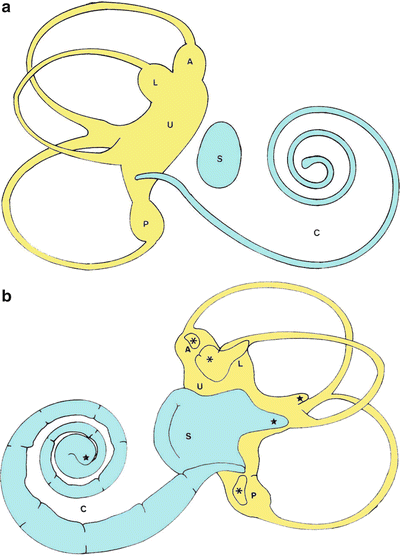



Fig. 5.3
Schematic representations of normal and pathological (hydrops and collapse) membranous labyrinths. (a) Normal membranous labyrinth. The pars superior is colored yellow, and the pars inferior blue. (b) Severe hydrops in both the pars inferior and the pars superior. Many infoldings are observed in the pars inferior, and three outpouchings (asterisks) are seen in the ampullae of the semicircular canals. The endolymphatic membrane at the apical turn has herniated through the helicotrema (stars). The saccular endolymphatic space occupies the vestibular perilymphatic space, attaching to the foot plate of stapes and herniating into the perilymphatic space of the nonampullated end of the lateral canal. The utricle has also expanded and herniated into the common crus. (c) Moderate hydrops in the cochlea and expansion of the saccular space filling the vestibule. (d) Hydrops and collapse in the cochlea. The hook portion of the basal turn (H) has expanded into the vestibule. A anterior semicircular canal, C cochlea, L lateral semicircular canal, P posterior semicircular canal, S saccule, U utricle (Modified with permission of the authors) (Courtesy of Drs. Okuno and Sando) [12]
1.
Severe hydrops in both the pars inferior and pars superior. Outpouching, infolding, and herniation are often observed (Fig. 5.3b). The severity of hydrops seems related to the severity of hearing loss.
2.
Moderate cochlear hydrops accompanied by hydrops of the saccule, but by milder or no hydrops of the utricle or semicircular canals (Fig. 5.3c).
3.
Hydrops with collapse of the membranous cochlea. The pars superior is normal in this group (Fig. 5.3d).
5.3 Diagnosis of Endolymphatic Hydrops Using Gadolinium MRI
Images of the inner ear can be obtained using gadolinium contrast agents.
Naganawa et al. [13] found that three dimensional fluid-attenuated inversion recovery (3D-FLAIR) imaging could minimize the ghost artifacts of fluid flow. The group studied the effects of contrast on the fluid of the inner ear [13, 14].
Nakashima et al. [15] visualized endolymphatic hydrops in patients with Meniere’s disease using intratympanic application of gadolinium. Using a 3 Tesla magnetic resonance imaging unit, they performed 3D-FLAIR imaging. Through the round window membrane in these patients, injected gadolinium entered the scala tympani of the basal turn, then spread toward the helicotrema and scala vestibuli. It also penetrated to the lower spiral ligament. One day after injection, gadolinium was observed in almost all areas of the perilymph. Six days after injection, gadolinium had almost disappeared from the inner ear.
Distension of Reissner’s membrane prevents gadolinium from entering the scala vestibuli. Likewise, gadolinium cannot enter the perilymphatic cistern in cases of marked distension of the saccular wall and/or the utricular wall occupying the vestibule.
Gadolinium 3D-FLAIR images showed marked endolymphatic hydrops in patients with Meniere’s disease. The cochlea and vestibule were occupied by endolymph, a change that was apparent when compared with images of the inner ear of normal subjects (Fig. 5.4a, c). There is no difference between T2-weighted images from individuals with and those without hydrops (Fig. 5.4b, d) [15].
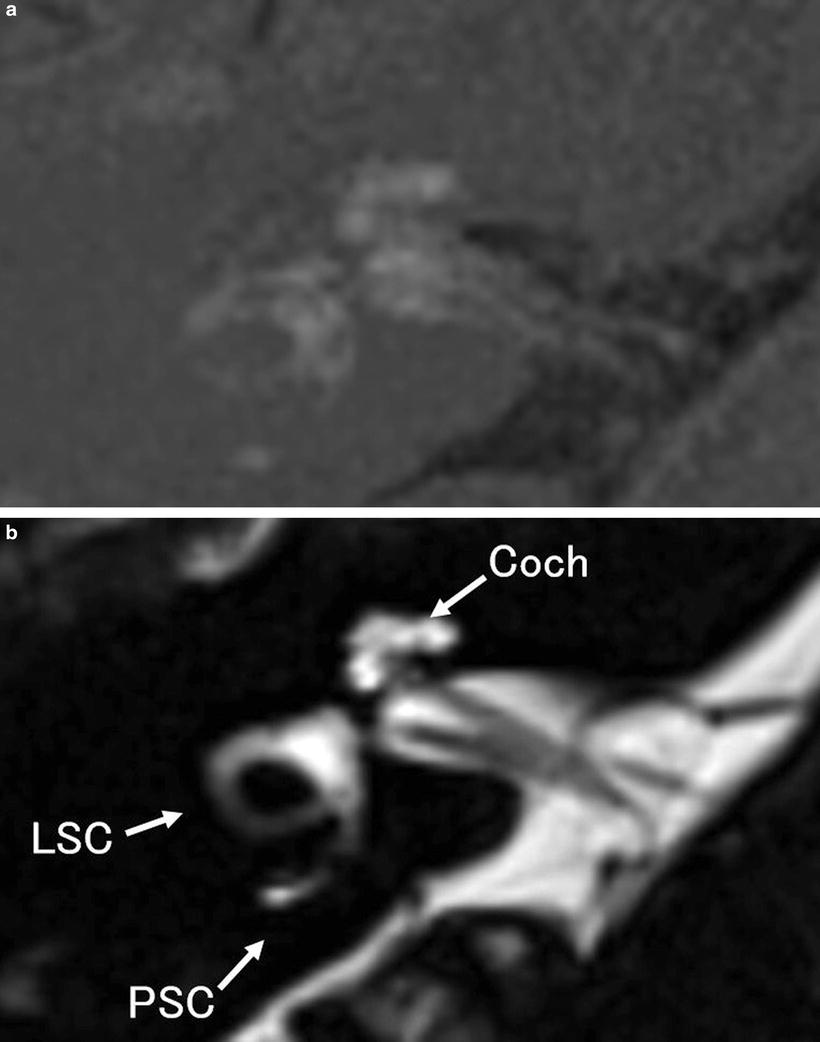
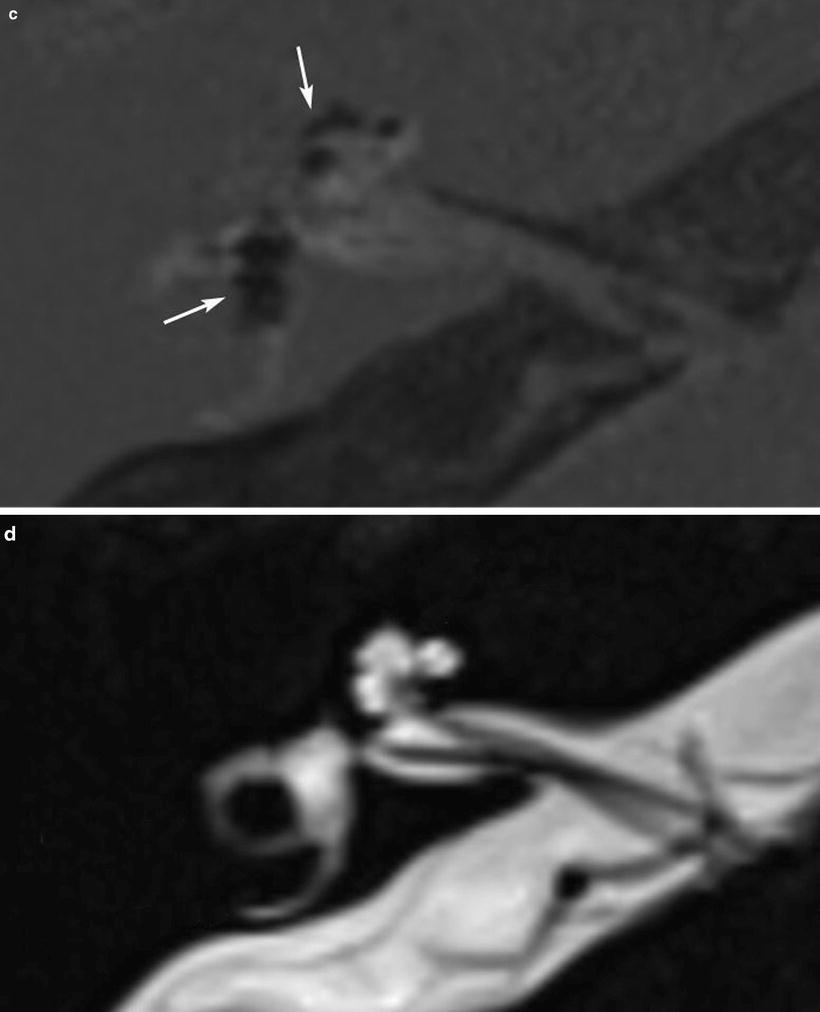


Fig. 5.4
MRI images of a normal inner ear and of the inner ear of a patient with Meniere’s disease. To visualize the total inner ear fluid anatomy, T2-weighted images were obtained using 3D-SPACE sequence. To separately visualize the endolymph and perilymph anatomy, HYDROPS (HYbriD of Reversed image Of Positive endolymph signal and native image of positive perilymph Signal) images were obtained. Technical details of HYDROPS images have been reported previously [17]. (a) Normal. HYDROPS image. (b) Normal. T2-weighted image using 3D-SPACE sequence. Coch cochlea, LSC lateral semicircular canal, PSC posterior semicircular canal. (c) Meniere’s disease. HYDROPS image. Hydrops is observed in the cochlea and vestibule (arrows). (d) Meniere’s disease. T2-weighted image using 3D-SPACE sequence (Courtesy of Drs. Nakashima and Naganawa)
A study of the distribution of gadolinium in the cochlear perilymph found differences depending on the method of delivery. In the intratympanic method, gadolinium-diethylene-triamine pentaacetic acid (Gd-DTPA, 500 mmol/L) was diluted eightfold with saline. In the intravenous method, a single dose (0.1 mmol/kg body weight) of Gd-DTPA-BMA was administered and heavily T2-weighted 3D-FLAIR was utilized. After intratympanic injection, gadolinium contrast agent distributed predominantly in the basal turn perilymph, whereas it distributed more uniformly throughout the cochlear perilymph after intravenous injection [16]. The cochlear fluid was found to be most intensely enhanced 4 h after intravenous injection [14].
Visualization of endolymphatic hydrops is useful not only for diagnosis of Meniere’s disease, but also for elucidation of its pathophysiology. Visualization will be of great help when selecting therapeutic modalities.
5.4 Experimentally Induced Endolymphatic Hydrops
In the cochlea, endolymph is produced by the stria vascularis. In the vestibular system, dark cells are considered responsible for endolymph production. The endolymphatic sac is the site of endolymph absorption, according to the longitudinal flow theory. Endolymphatic hydrops is believed to occur when the endolymphatic duct and/or sac is obliterated.
In 1964, Kimura successfully produced a guinea pig model of endolymphatic hydrops by obliterating the endolymphatic duct. His technique spread worldwide as a standard experimental method of producing endolymphatic hydrops and contributed to morphological and physiological studies of Meniere’s disease [17–19].
The author received a set of experimental endolymphatic hydrops specimens from Dr. Kimura in September 2000. The specimen box was labeled with the following information:
Guinea Pig Hydrops
Blockage of endolymphatic duct
October 1980
Duncan Hartlay Strain
Weight: 438 g
Survival time: 4 months
Fixative: Heidenhain-Susa
Section: 20 μm serial
Stain: Hematoxylin-Eosin
Hydrops shown in: Cochlea,
Saccule, Utricle, Posterior +
Superior Ampullae
The specimens showed hydrops in almost all parts of the inner ear (Fig. 5.5a–d).
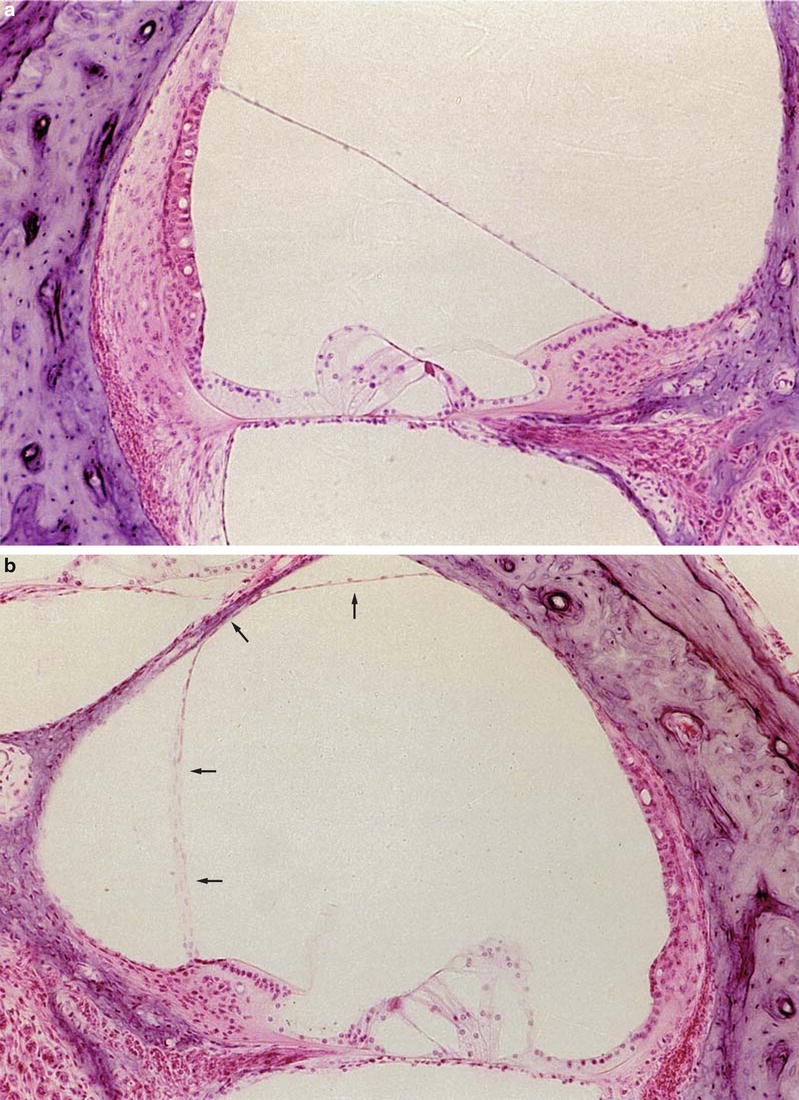



Fig. 5.5




Experimentally induced endolymphatic hydrops in the guinea pig. These specimens were made 4 months after obliteration of the endolymphatic duct and sac. (a) Control showing normal structure. (b) Markedly distended Reissner’s membrane (arrows). (c) Normal structure on the control side 1: endolymphatic duct, 2: endolymphatic sac, 3: operculum, 4: lateral sinus. (d) Obliteration of the endolymphatic duct and sac (Courtesy of Dr. Kimura)
Stay updated, free articles. Join our Telegram channel

Full access? Get Clinical Tree


